IPHO '99 NEWS
- July, 24, 1999 -
Supplement to the n.3 of "La Fisica nella Scuola"
Managing Director: Luigi Brasini
AND NOW... RELAX
(only for students)
Not only Physics
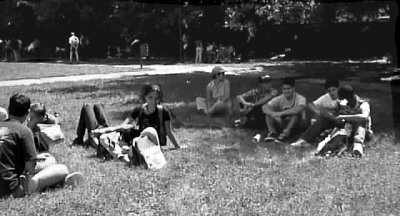
|
|
Cuba team: Ramazzotti, Grignani, Pausini... viva Italian music!
|
|
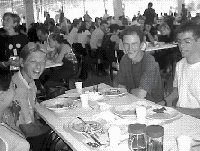
|
|
Mechanics?! They play volley-ball, foot ball, baseball, judo, karate, soccer, athletic, cycling, tennis, rafting... pin-table.
|
|
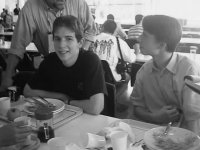
|
|
Acoustic?!! Who listens... pop, disco, rock, punk, techno and house music. Who plays... piano and organ for 12 years as Houza Houstek.
|
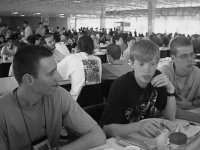
|
|
The future?! Physics, cybernetics, engineering...
|
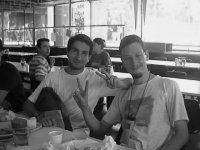
|
The Recoil Mass Spectrometer CAMEL
|
|
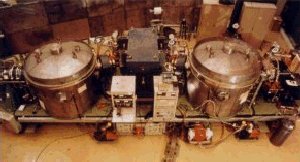
|
|
Fig.1: The "CAMEL" Recoil Mass Spectrometer
|
|
|
|
The Recoil Mass Spectrometer (RMS) is an instrument used for the identification and analysis of the nuclei produced in fusion nuclear reactions. In such type of reactions the different isotopes, produced after the evaporation of a few nucleons from the compound nucleus, recoil in the forward direction and can be collected with good efficiency within the ~10 msr angular acceptance of CAMEL (fig.1) .
|
|
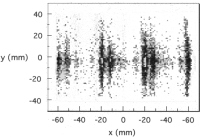
|
|
fig.2: A typical image at the RMS focal plane: position distribution of the fusion-evaporation recoils produced in the reaction of a beam of 54Fe at 240 MeV onto a 92M0 target.
|
|
|
|
The sequence of the three deflecting elements, two electrostatic separators and one magnetic dipole in between (plus a few magnetic quadrupoles to help in the optical focusing), produces, at the end of the RMS, a focal plane where the transmitted ions are dispersed in proportion to the ratio m/q between their mass and ionic charge, while being also focused in position and energy (fig. 2). The m/q resolution is about 1/300.
Several different radiation detectors can be arranged around the focal plane, as well as around the target position at the entrance of "Camel".
At the focal plane a multiwire gas detector gives the necessary position information and the time of arrival of the particles. Other detectors can be added to measure the delayed radiation (alfa, beta, gamma and protons) eventually emitted by particles after implantation onto a suitable support. New detectors of this type are under development.
|
|
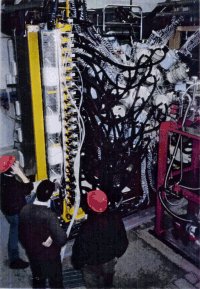
|
|
fig.3: The large gamma detector array "GASP".
|
|
|
|
Around the target other similar detectors can measure the prompt radiation emitted during the de-excitation of the compound and residual nuclei. Among these associated detectors, a special case is represented by the large gamma detector array "GASP" (fig. 3), which has been developed as a separate facility, but can be coupled to the RMS (fig. 4).
The use of the two instruments, GASP and RMS, coupled together is particularly useful for studies of the nuclear structure of "exotic" nuclei produced in fusion-evaporation reactions, e.g. very proton rich nuclei.
The characteristic radiation emitted by very weak reaction channels can be extracted from the overwhelming amount of other radiations (produced by the competing strong reaction channels) by doing the measurements in coincidence with the nucleus identification signals obtained from the RMS.
|
|
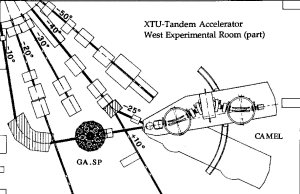
|
|
fig.4: CAMEL and GASP apparatus and the beam lines set-up in the west experimental room of the Tandem-Alpi accelerator complex.
|
|
|
|
Even more selective are the signals provided by the delayed decay of nuclei implanted onto solid state detectors at the RMS focal plane. Meaningful events can be extracted out of a natural background about 5 orders of magnitude higher.
The selection capability of the RMS can, of course, be exploited also in the "standalone" configuration, i.e. without GASP, for studies of reaction mechanisms (e.g. enhanced nuclear fusion below the Coulomb barrier) or identification of new nuclei and their decay modes.
by INFN Legnaro Laboratories
Toys and Science
On the occasion of the XXX edition of the International Physics Olympiad, the Department of Physics of the University of Trento introduces a show entitled "Toys and Science". This show was born from an idea of Prof. Vittorio Zanetti, for years responsible for the search in the Laboratory of PhysicsTeaching of our University. Inaugurated in Trento in 1992, this toy exhibition has become "itinering" and has touched a lot of Italian regions and foreign countries such as Switzerland and Poland.
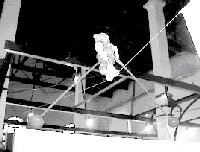 The toys exhibited have been chosen either because they are definitely amusing and because they work on the base of particularly interesting physical principles. Visitors can make some toys work directly, while others, more complex and fragile, are activated only by special staff, that drives the visitors through the show.
The toys exhibited have been chosen either because they are definitely amusing and because they work on the base of particularly interesting physical principles. Visitors can make some toys work directly, while others, more complex and fragile, are activated only by special staff, that drives the visitors through the show.
The exhibition includes about seventy toys showing apparently paradoxical aspects of mechanics, optics, thermodynamics, astronomy, chemistry and electricity. The aim is to stimulate the visitor and to rouse his interest in the world that surrounds him, and its laws, showing that the behavior of the toys can be interpreted in a simple and meaningful way, even if at different levels, according to the visitor's school and culture. In this way, objects born to amuse and charm people can also be exploited for learning, and, above all, to have a positive impact with Science: you can admire a nice duck - a toy dipping its beak repeatedly into a glass full of water that doesn't seemt to have any need for energy to complete its movements; there is a ping pong little ball that keeps its balance on a blast of air, even if the good sense tells us that it would fall in a twinkling! Moreover, there is a row of pendulums that, when opportunely bumped, behaves in strange way! Not to mention the tops which refuse to rotate in a direction, and rather, if forced to rotate in that way, after a while they rebel and reverse their sense of march. And…. this could be the good occasion to see the cubic soap bubbles!
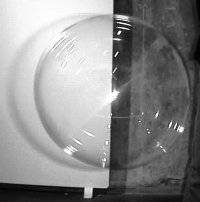 These are just some examples which give an idea of the type of the exposed objects: toys showing an apparently magic behavior, that, on the other hand, is perfectly explainable with the laws of Physics and, as such,understandable for everybody, even if at different levels. The leading idea that has driven the searches of our group of didactics is that Science is not a tool for few people (researchers and so on…) , but it constitutes integral part of the daily life of each of us. Thanks to such shows an extremely elevated number of people can be reached, and they generally bring impressions that are much more positive and lasting than a lecture or a telecast.
These are just some examples which give an idea of the type of the exposed objects: toys showing an apparently magic behavior, that, on the other hand, is perfectly explainable with the laws of Physics and, as such,understandable for everybody, even if at different levels. The leading idea that has driven the searches of our group of didactics is that Science is not a tool for few people (researchers and so on…) , but it constitutes integral part of the daily life of each of us. Thanks to such shows an extremely elevated number of people can be reached, and they generally bring impressions that are much more positive and lasting than a lecture or a telecast.
The exhibited objects succeed in stimulating a lot of questions and connections with daily experience. The idea that Science penetrates the world which surrounds us, included the humblest objects, comes clearly out by the behavior of the toys, which have the advantage of being highly "motivating" in comparison with the typical objects of laboratory. Such ideas still keep on characterizing the studies of the present responsible of the Laboratory of Physics Teaching at the University of Trento, dott. Luigi Gratton. The show will be prepared by the collaborators of his laboratory, with the collaboration of prof. Vittorio Zanetti. It is definitely the case to wish the visitors that will join us the show…Have a good time!!!
by Vittorio Zanetti & Elvira Biasioli
Laboratorio dell'immaginario scientifico
A new science centre
21 June 1999, a new science centre of the last generation opened in Grignano-Trieste. On the sea side, near the castle of Miramare, the Laboratory of the Scientific Immaginarium is an interactive museum to play and uderstand, to keep up to date with scientific and technological research, to understand our present and glance curiosity at the future. To meet the various interest of visitors, we devided in five main section which give the opportunity to approach science in different ways.
|
ELIS - DIDIECINDIECI
|

|
A spectacular journey, from the endless edges of our Universe to the subatomic dimensions of the smallest particles: from quasar to quarks, we will float on the rythm of original musics and enjoy more than 600 slides with their own captions, projected on 10 maxiscreens. If you want to learn more an intaractive multimedial station will present insights and extra news on the most appealing pictures.
|
|
AREA - HANDS-ON EXHIBITS
|

|
Visitors are encouraged to follow the various thematic itineraries, to have fun playing with mirrors, tubes, lights and the shadows of the interactive hands-on exhibits section. Area is the core nucleus of the new generation interactive museum: both children and adults may be the prime actors and perform several experiments to reproduce and understand,through direct experience, many natural phenomena.
|
|
ALADINO - SCIENCE AS A GAME
|

|
Enter our laboratory no matter who you are, kids or grown-ups. You will experience a fit-for-curiosity open space where science is in the limelght. Looking at every-day phenomena from inside you will be able to understand many things that usually go unnoticed.
|
|
DEDALO - INFORMATICS AND MULTIMEDIA
|

|
Here you wil find Science no-limits, supported by informatic resources and telematic systems. Dedalo station, updated on a regular basis, offer to the web surfers the best Internet sities dedicated to scientific images. Plus: multimedial works, educational CD-ROMs, links with laboratories and research centers, together with the italian version of all the best from worldwide science centers.
|
|
ALTROMUSEO - MUSEUMS IN THE MUSEUM
|

|
Altromuseo is a space where several Museums from the midEurope present their prestigious collections of scientific items. Ancient instruments which marked the course of scientific research are flanked by hands-on exhibits, interactive stations and multidedia productions, where informative windows are explicative of the basic activities hosted by the various Museums.
|
Special Thanks!
to all the staff of buses companies
ACAP, SITA and APT
for their efficient service.
Happy birthday!
GIULIANA PISERI
(Examiners group)
BACK









 The toys exhibited have been chosen either because they are definitely amusing and because they work on the base of particularly interesting physical principles. Visitors can make some toys work directly, while others, more complex and fragile, are activated only by special staff, that drives the visitors through the show.
The toys exhibited have been chosen either because they are definitely amusing and because they work on the base of particularly interesting physical principles. Visitors can make some toys work directly, while others, more complex and fragile, are activated only by special staff, that drives the visitors through the show.
 These are just some examples which give an idea of the type of the exposed objects: toys showing an apparently magic behavior, that, on the other hand, is perfectly explainable with the laws of Physics and, as such,understandable for everybody, even if at different levels. The leading idea that has driven the searches of our group of didactics is that Science is not a tool for few people (researchers and so on…) , but it constitutes integral part of the daily life of each of us. Thanks to such shows an extremely elevated number of people can be reached, and they generally bring impressions that are much more positive and lasting than a lecture or a telecast.
These are just some examples which give an idea of the type of the exposed objects: toys showing an apparently magic behavior, that, on the other hand, is perfectly explainable with the laws of Physics and, as such,understandable for everybody, even if at different levels. The leading idea that has driven the searches of our group of didactics is that Science is not a tool for few people (researchers and so on…) , but it constitutes integral part of the daily life of each of us. Thanks to such shows an extremely elevated number of people can be reached, and they generally bring impressions that are much more positive and lasting than a lecture or a telecast.




